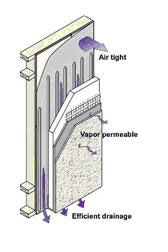EIFS Update: Pick the Right Substrate
Comparing Wall Systems
Part of the evolution of EIFS to their current improved state has been extensive testing and research on types of wall systems and comparisons with other, traditional wall systems. Among other studies, one notable one has shed considerable light on the science and performance of these systems. The U.S. Department of Energy (DOE), through the Office of Energy Efficiency and Renewable Energy's (EERE) Building Technologies Program, and in conjunction with the EIFS Industry Members Association (EIMA), sponsored an Exterior Wall Cladding Study which was conducted by researchers at the Oak Ridge National Laboratory (ORNL). A building was constructed near Charleston South Carolina, containing multiple wall panels with various wall claddings and assemblies.
Each of these wall panels contained sensors that provided a full profile of temperature, heat flux, relative humidity, and moisture content. These sensors collected data 24 hours a day, 7 days a week, and transmitted the data to the ORNL research facility in Oak Ridge, Tennessee for analysis. One of the strengths of this study is that it considered the building envelope in its entirety, along with studying isolated materials or components of the exterior claddings. The other strength is that the wall was exposed to real climactic loads. As a result, this study allowed the researchers to gather real-world data over a 30-month period between January 2005 and June 2007. The Phase 1 and Phase 2 results of this study were released on August 15, 2008.
The focus of this 30-month evaluation was on the overall moisture and thermal (hygrothermal) performance of EIFS, stucco, and masonry walls. The following excerpt from the Executive Summary of the report outlines the key findings of this study, all of which are applicable to a mixed, coastal, Zone 3 climate similar to Charleston, SC:
- One of the best performing wall system configurations was comprised of EIFS that included a liquid applied water-resistive barrier coating and four (4) inches of expanded polystyrene insulation board. In addition, all of the thermal insulation was placed outbound of the sheathing (no stud cavity insulation). This EIFS wall configuration performed better than brick. Brick had the lowest thermal and moisture performance among the claddings and wall configurations studied, followed by stucco (both 3-coat and 1-coat).
- EIFS walls maintained a consistent, acceptable level of moisture (average monthly relative humidity below 80 percent, as defined by the American Society of Heating, Refrigeration, and Air Conditioning Engineers (ASHRAE) SPC 160P, now referred to as ANSI/ASHRAE Standard 160 Criteria for Moisture- Control Design Analysis in Buildings within the cladding despite varying outdoor conditions when appropriate interior vapor retarders were used. Brick and stucco tended to accumulate slightly more moisture during both Phase I and Phase II of the project and retained moisture longer than EIFS.
- EIFS and a liquid applied water-resistive barrier coating readily dispersed moisture introduced by flaws (installed in Phase II) in the building envelope, as compared with brick, which retained more water.
- Liquid applied water-resistive barrier coatings, in certain instances, outperformed other water-resistive barriers in this study. In addition, EIFS with water-resistive barrier coatings performed significantly better than other EIFS claddings that used building paper or spun-bonded polyolefin membranes. The results also indicated that building wraps permit greater vapor transport inward in mixed climates.
- Insulation located on the exterior (outside of the stud cavity) is more effective since it maintains the sheathing and insulation at drier levels. This has important implications for preventing material degradation.
- The results of this study validate that vertical ribbons of adhesive provide an effective means of drainage within an EIFS clad wall assembly.
 |
Figure 4: ORNL determined that the best performing system used non-insulated cavity walls, a drainage plane membrane, vertically applied adhesive, and a 4" EIFS cladding. Image courtesy of ORNL and EIMA |
Each of these findings demonstrates and validates the prevailing practices related to the design and installation of EIFS in buildings. As such, they essentially declare that prior problems experienced with this cladding technique have not only been overcome, but that they surpass other traditional systems such as masonry and stucco walls in terms of hygrothermal performance. Further, the wall system found to have the best overall performance, namely an EIFS with 4" of EPS insulation and an air barrier (See Figure 4)meets or exceeds all ASHRAE and Core Performance Guide insulation and air barrier requirements in the continental U.S. and much of Alaska. The stated results of this study are summarized as showing that:
"EIFS are capable of controlling temperature and moisture within the wall system and outperform other exterior claddings during the monitored year. In essence, EIFS have the ability to maintain an acceptable balance of moisture and temperature control that is indicative of a well-designed, properly operating energy efficient building without moisture problems. All of the wall configurations evaluated in this study performed satisfactorily. This study convincingly proves that EIFS is an excellent choice for achieving key building performance goals, including energy efficiency, moisture and temperature control. EIFS absorbs less moisture and heat as does brick and stucco. These results clearly and convincingly demonstrate the superior performance of EIFS in a mixed, coastal, Zone 3 climate."
A complete report on both Phase I and Phase II is available at theOak Ridge National Laboratory web site.









